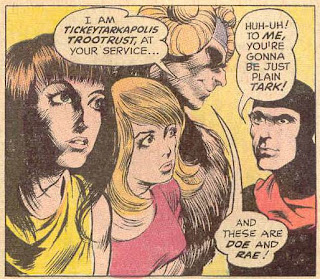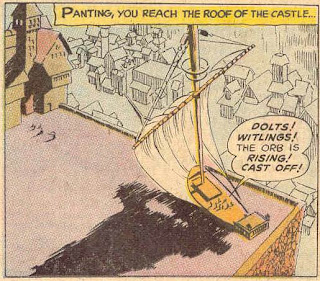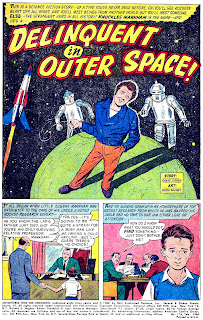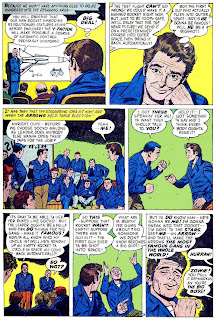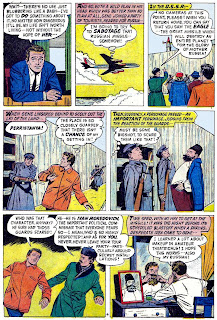The second issue of the Nightmaster Showcase trial featured the art of Bernie Wrightson, who had just started his comic book career a month or so earlier. Wrightson's style was obviously heavily influenced by Frank Frazetta, which made him particularly suited for the genre. Frazetta's magnificent illustrations had covered the recent Conan series of books published by Lancer/Ace.
The story takes up where the previous one left off. Having learned the passwords from the Ice Witch, Nightmaster and his somewhat deranged guide, Boz, are trying to save Jan from the evil warlocks. They run into a challenge from a Conan clone:
Note the unusual use of inks there; the straight lines on Nightmaster's face as compared to the cross-hatching on the barbarian's. This is not original with Wrightson by any means, but it was a style associated with more mature and sophisticated artists, like Al Williamson.
Nightmaster manages to defeat the barbarian by throwing away his sword and using a little judo. Because he refuses to take his opponent's life, the barbarian agrees to help him. It turns out he has two additional companions for the party:
They are sirens, whose voices have been stilled by the evil wizards and locked away in a chest. So their goals coincide as well. Wrightson was known for drawing exceptionally beautiful women. Probably his most famous issue had this mesmerizing cover:
They make it to the warlock stronghold, where they stop at an inn. I guess the CCA was asleep at the switch again on the use of alcohol, as they order ale and:
There's the somewhat obligatory battle with some guards who show up:
Entering the warlock castle, they find the chest holding the voices of the two sirens. Then they reach the roof, where a moonship is preparing to lift off:
I like the concept of a ship that sails through the air, powered by the light of the moon. They manage to get over the gunwales before the craft escapes, and Nightmaster discovers that Jan is aboard:
They battle some enchanted warriors, who cannot be defeated, and thus they are forced back to the rails of the ship:
Very nice bit of sequential art there. The story ends with the moonship sailing away, much to Nightmaster's frustration:
The combination of two of comics' brightest young talents certainly improved things over the previous issue. This one is not quite perfect, but there are more than a few glimmers of potential that could have resulted in something special had the series been given the time to percolate and develop an audience. Unfortunately, DC was under rising pressure due to the inflation of the late 1960s (in fact, this was the last 12-cent issue for Showcase) and so had no inclination to wait to see if this series would sell long-term. Given the success that Marvel had with Conan the Barbarian only a year later, it seems quite likely that Nightmaster could have turned into a winner.
A bit of trivia here: Do you know the last series that Showcase launched into its own book? It was Windy and Willy, which debuted one issue before Nightmaster. Can you guess why? Well, my guess is because DC recycled the old Many Loves of Dobie Gillis series for that comic (with only a few changes to update hairstyles and fashions), and thus it was cheaper to produce than a comic that required new stories and art.














 *True.
*True.




















